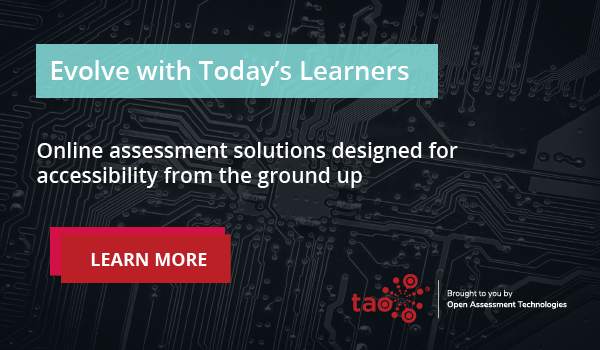For many learners around the world, remote learning has leveled the playing field by providing access to high-quality curricula regardless of location. However, access is not enough. With over 240 million children with disabilities worldwide, educators must be also able to differentiate and accommodate assessments to meet the needs of all learners in a remote environment.
Online learning tools offer unique solutions to traditional issues around inclusivity, while at the same time creating a whole new set of challenges that need to be addressed for online learners. Luckily, there are tools and techniques that educators can implement online to promote inclusivity in the virtual classroom.
What does inclusive online learning look like?
An inclusive online learning environment allows students from different backgrounds and of different ability levels to create meaningful and impactful learning throughout a lesson. By ensuring that learning is open-ended and that students can show their learning in multiple ways, educators enable more students to demonstrate their skills.
Inclusivity is especially important in online assessment and having an inclusive assessment software is critical for remote learning. With nearly 15% of all students in the United States eligible for special education services, it is necessary to have a suite of online testing tools that allow all students to demonstrate what they have learned. In doing so, educators can better understand their students’ abilities and identify areas of strength and areas for growth.
Access and accessibility in online learning
Providing access is the first component of building a successful online learning program. Students need devices and a stable internet connection to access remote learning. Once these elements are in place, some students may need additional training on the functionality of devices and how to navigate online tools, especially if the students are new to schooling or have minimal experience with technology.
Within the online learning platform itself, instructors must consider many factors for accessibility so that all students can reach their full potential. Designing courses and assessments for all learners means that educators apply the principles of Universal Design Learning (UDL) including:
- Providing information in multiple ways– students don’t all learn in the same way, and online learning tools allow instructors to give students many options for engaging with the curriculum. A teacher could use video, written notes, hands-on activities, and other multimedia to give students more authentic learning opportunities.
- Providing many opportunities to show learning – students may understand a concept but may not be able to express their learning in traditional ways. By allowing students to have a variety of options for expressing learning, such as writing, creating a presentation, or even developing a real-world solution to a problem, students can show what they know.
- Providing flexible participation – class participation is critical to building knowledge and developing interpersonal skills. Within the UDL framework, students can engage in the lesson in different ways including through voice, text, and even using pictures.
Creating an accessible online learning environment can seem overwhelming, especially for teachers that may not feel comfortable with technology themselves, however, there are a wide variety of accommodation tools available for online learning.
Accommodation tools for online learning
For online test-takers, having the appropriate tools available within the testing interface means that they can focus on the content of the test, rather than the process of test-taking. Online testing oftentimes offers a wider array of accommodation tools than is available within the traditional classroom. Some of the tools available include:
- Text to speech – having digital text read aloud lowers a barrier for developing readers and can facilitate greater comprehension than with text alone.
- Dictation – for a student that struggles to put pen to paper or type responses quickly, having a dictation feature can be a necessary accommodation.
- Screen manipulation capability – allowing students with vision impairment to magnify the screen, change the color scheme, or even change font styles can make reading a text more accessible.
- Primary language translation – for test-takers that do not speak the primary language that a test is given in, it is possible to provide translations within the test itself to ensure that all students can access the information.
- Provide transcripts for all media – video and audio elements are often included in online testing, however, the pace of these media can make it difficult for all learners to keep up. By providing the option of a transcripted video or audio students can verify what they are listening to and improve comprehension.
Although this list may seem extensive, it is important to remember that not all students will be utilizing all accommodations, and many of these accommodations can be added to an online test with a click of a button.
Other considerations for inclusive online learning
Apart from accommodating assessments and ensuring inclusion, there are a few of other considerations that educators must think about when designing an online learning environment. These include the legal requirements for the location where the class is taught, as well as considering the language requirements of the students.
Legal requirements
While legal requirements may vary based on region and country, educators can ensure that they are meeting requirements for student access by leveraging tools that follow the Web Content Accessibility Guidelines (WGAC). Within the US, educators must always follow the guidelines set forth by IDEA, section 504, and a student’s Individualized Education Plan (IEP). Of course, this also applies to any online test software or curriculum given within a school, even if it is in a virtual school environment.
Language localization and language considerations
In addition to the legal requirements, there are also language considerations to take into account when designing an online learning curriculum. Depending on the physical location of a school’s students, there may be many languages represented in one class. By building in the ability to change the language localization, educators can give students the opportunity to read and respond in a language that they are comfortable with.
Enhanced learning is the end goal
When all is said and done, all online testing and learning accommodations aim to enhance student learning outcomes and increase student growth. By creating an inclusive virtual learning environment, teachers can ensure that all students are learning as much as possible without barriers that may exist otherwise.
Creating an inclusive online environment doesn’t have to fall on the shoulders of already busy teachers. At Open Assessment Technologies we have technology tools that can enhance accessibility and improve student engagement and growth without putting an extra load on educators. To learn more about how TAO can help, reach out here to learn more.

